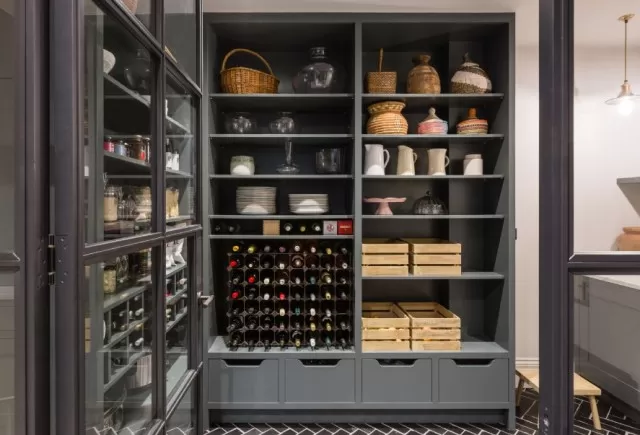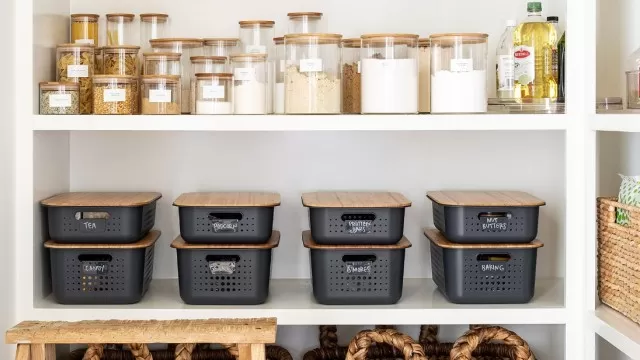If you have spacious kitchen pantry shelves, they can be a valuable asset for passionate cooks, bulk shoppers, and those catering to a large household.
However, deep pantry shelves can quickly become a breeding ground for clutter, resulting in expired food and forgotten ingredients.
It’s common for items to be pushed to the back of shelves, only to be rediscovered during a pantry clean-out.
This not only leads to food waste but also causes unnecessary grocery expenses.
When you can’t see the cans of tomato sauce hidden behind cereal boxes, you’re likely to purchase duplicate items on your next grocery trip.
If this situation resonates with you, take solace in the fact that even with a deep pantry, you can establish a functional and organized space.
We’ll share some effective storage ideas for tackling clutter on deep pantry shelves, enabling you to conquer the chaos once and for all.
Methods to Organize & Store Deep Pantry Shelves

Establishing a Zoning System.
When arranging your pantry, it’s essential to consider which items to store and where to place them.
This becomes even more important when organizing deep pantry shelves. One effective strategy is to assign each shelf or section a specific pantry zone, such as baking supplies or breakfast ingredients.
It’s advisable to position the most frequently used zones towards the front and at eye level for easy access. For example, if you want children to be able to grab their own snacks, place a container on a lower shelf within their reach.
Less frequently used items, such as seasonal ingredients or specialty items, should be placed toward the back of the shelves.
If you have multiple containers of the same item, like canned vegetables or soup, consider employing a method similar to grocery store aisles. Line up multiples of the same item in a row, with the oldest expiration date in the front.
While it may take a bit more effort to rearrange items as you restock, this approach ensures that you utilize or consume items before they expire.
Utilize Clear, Deep Containers.
Opting for clear bins or containers not only helps keep your pantry items organized but also allows you to easily see what’s inside.
If possible, acquire a set of bins that align with the depth of your pantry shelves and arrange them with the shorter side facing outward. By dividing your pantry into zones and keeping similar items together, you can quickly locate what you need while cooking.
Look for containers with handles, as they enable you to pull them forward for a quick scan.
Install Pull-Out Drawers.
If your pantry doesn’t already have pull-out drawers, consider incorporating them as they provide the best accessibility to stored items.
There are two options to achieve this: replacing static shelves with gliding drawers or attaching pull-out drawers to the existing shelves. Both methods require accurate measurements, some DIY skills, or the assistance of a professional.
Despite the initial investment of time and money, the convenience and long-term savings make this project worthwhile.
Pull-out drawers allow you to slide them forward, providing a clear view and easy access to everything inside.
No longer will you have to rummage through the back of shelves searching for that bag of cookies you hid away from the kids.

Arrange Items by Height.
Whether using drawers or shelves, organizing items by height is a helpful practice.
If you prefer storing baking supplies in matching containers, place shorter containers filled with items like nuts or chocolate chips in the front, and line up taller containers holding sugar and flour behind them. This arrangement allows you to see all items on the shelf at once.
In the case of products with similar heights, such as canned goods, using a deep riser with at least three rows can be likened to stadium seating. Despite their uniform size, all cans remain visible and easily accessible.
Incorporate a Lazy Susan.
The versatility of a Lazy Susan makes it suitable for organizing various spaces in your home.
For deep pantry shelves, select a Lazy Susan with a large diameter. Use it to store round items, maximizing the storage space.
Bottles of oils, different types of vinegar, condiments, cans, and jars are ideal candidates for the Lazy Susan. Once it’s set up, you can effortlessly rotate the Lazy Susan to find what you need, eliminating the need to reach for items at the back and potentially causing a mess.
Utilize Pantry Doors.
Pantry doors often go unnoticed as potential storage spaces.
If your pantry doors are not bifold or pocket style, consider adding an over-the-door organizer. These organizers can hold small items that tend to get lost among the deep shelves.
Shallow baskets attached to the back of the pantry door can comfortably accommodate spices, seasoning packets, or grab-and-go snacks like granola bars. This ensures that these items are easily visible and within reach.

Label Everything.
Labeling is key to maintaining an organized pantry.
Apply labels to containers, food storage jars, and even the shelves themselves. Pantry labels benefit everyone in the household, providing clear guidance on where to find specific items and where to return them.
General labels or broad categories can save you the hassle of frequent changes. Alternatively, consider using dry-erase labels for more specific and adaptable labeling.
Maximize Pantry Storage Space.
While it may be tempting to fill your pantry to the brim, it’s important to resist the urge.
Avoid overcrowding shelves with excessive products that may eventually expire. Instead, make use of excess pantry space to store Small Appliances or bulky items such as paper towels.
This way, you optimize your storage capacity while ensuring that items remain easily visible and accessible.
Regularly Declutter.
The key to maintaining an organized pantry with deep shelves is to declutter regularly.
Commit to going through your pantry regularly, aiming for weekly decluttering sessions. Before heading to the store or placing an online grocery order, take a few minutes to assess your pantry and determine what you need and what you have an excess of.
If you’ve already implemented some of the strategies mentioned, this process should be quick and effortless. Regular decluttering helps keep your pantry organized and prevents unnecessary accumulation of items.
*The information is for reference only.